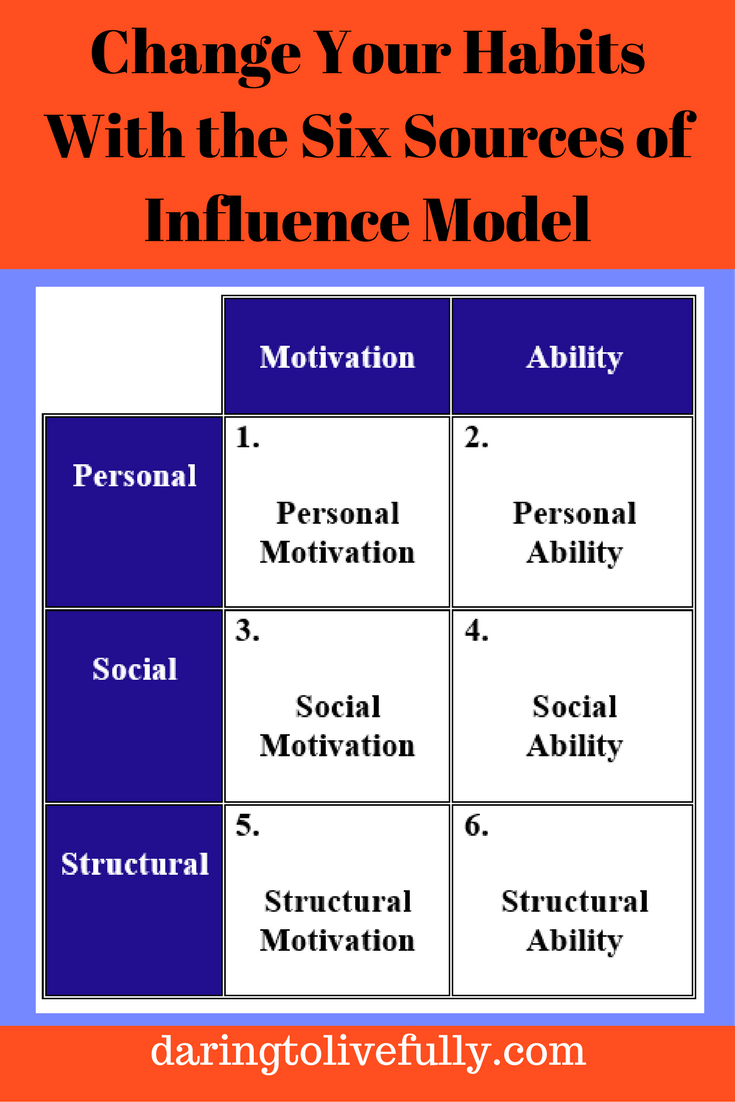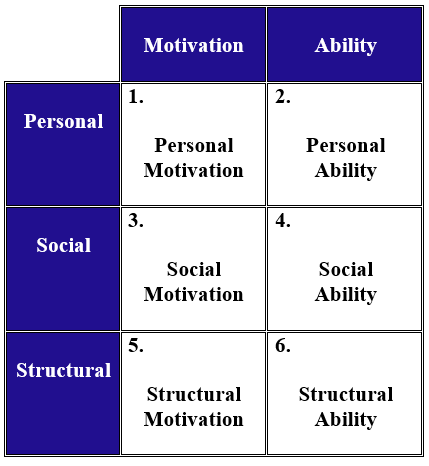
Make behavioral change 10x easier with the Six Sources of Influence Model.
It can be difficult to change your habits and behavior. This is particularly true when the behavior that you’re trying to change is long-standing. Fortunately, there are models you can use to make this easier.
One of these is the Six Sources of Influence Model. Research has found that those who used this model were 10 times more likely to produce profound behavior change.
You’ll find an explanation of the model, and how to apply it, below.
The Six Sources of Influence Model
The Six Source of Influence model consists of two columns and three rows. One column is for motivation, and the other column is for ability. The rows, in turn, represent the following:
- The Individual — you.
- Society — the people around you.
- The Environment — your surroundings (nonhuman factors such as compensation systems, space, and technology).
More specifically, each of the squares of the model stands for the following:
- 1. Personal Motivation—whether you want to do it. You increase your motivation by making things fun and enjoyable, and by making sure that the goal you’ve chosen is aligned with your values.
- 2. Personal Ability—whether you can do it. New behaviors can be far more intellectually, physically, or emotionally challenging than they appear on the surface. Do you have the skills and the knowledge necessary to do what needs to be done? If not, can you acquire these skills and knowledge?
Society
- 3. Social Motivation—positive or negative influence by others. Are other people encouraging the right behavior and discouraging the wrong behavior? Peer pressure is powerful, even when you’re an adult.
- 4. Social Ability—whether other people provide help to do it. Do others provide the necessary help, information, and resources? Is there someone who can make it easier for you to acquire the new habit or behavior? Can you hire a trainer, an instructor, or a coach?
The Environment
- 5. Structural Motivation—whether the environment encourages you to do it. Is there a reward system in place? Is there some sort of negative consequence if you don’t follow through?
- 6. Structural Ability—whether the environment supports you doing it. Are there enough cues for you to stay on course? Does the environment enable the right behaviors or discourage the wrong behaviors?
Here’s what the model looks like:

In the next section I’ll show you an application of the model.
Application of the Six Sources of Influence Model
Al Switzler, co-founder of Vitalsmarts, LLC, gave a TED Talk in which he explains why it’s so easy to lose weight at a weight-loss retreat or resort, but then it’s difficult to keep the weight off once you’re back at home.
The reason is that, at the retreat, the six sources of influence are working to help you. However, once you’re back at home, most of the sources of influence work against you.
At the Retreat
Here’s how a weight-loss retreat uses the six sources of influence to help ensure your success in losing weight:
- Personal Motivation. The fact that you’re at a weight-loss retreat is evidence of how motivated you are to lose weight.
- Personal Ability. During your time at the retreat you get pamphlets explaining how the food that you’ll be eating will help you to lose weight, you go to cooking classes, and you get to attend lectures by world-renown weight-loss experts giving you tips and pointers on how to prepare healthy meals.
- Social Motivation. Everyone else at the retreat is also trying to lose weight, so you all encourage each other. All of the participants support each other to stay on track.
- Social Ability. The staff at the retreat is very knowledgeable, and they’re available at any time to help you with whatever you need. They give you feedback and they motivate you to follow the program.
- Structural Motivation. The retreat probably has some sort of a reward system set up to encourage the participants to eat the right foods, attend exercise classes, go for walks on the retreat grounds, forego sweets, and so on.
- Structural Ability. Everything at the retreat is set up to help you along your weight-loss journey. A healthy breakfast is delivered to your room each morning, the calm surroundings are conducive to focusing on wellness, there’s always a hiking expedition or an exercise class you can join, and so on.
You can clearly see why it’s almost a certainty that you’ll succeed in losing weight at the retreat.
At Home
However, here’s what usually happens to the six sources of influence once you go home:
- Personal Motivation. You’re still motivated to continue losing weight and to keep the weight off, so at least this source of influence is still working in your favor.
- Personal Ability. You may struggle to replicate the meals that you ate at the retreat. The meals probably won’t taste anywhere as good as they did when the professionals were preparing them at the retreat. In addition, some of the ingredients may be difficult to find. This source of influence is now working against you.
- Social Motivation. Your friends are probably going to be calling you up constantly to join them for the all-you-can-eat buffet at the club, go for drinks, or celebrate someone’s birthday with cake and ice cream. Therefore, peer pressure will be working against you.
- Social Ability. If you don’t have anyone around you with weight loss expertise–such as a coach or a knowledgeable friend–then this source of influence won’t be working in your favor.
- Structural Motivation. There’s no incentive or reward system set up to energize, excite, and motivate you to continue with your weight-loss efforts.
- Structural Ability. Controlling your space will become much more difficult. It’s very likely that your family members will bring all sorts of junk food into the house. Therefore, every time you open the refrigerator you’ll have to struggle with the urge to eat a brownie or have some leftover pizza.
Can you see why it’s highly likely that you’ll gain all the weight back once you’re at home? There are more influences for gaining the weight back than there are for keeping it off. That is, unless you find a way to get the six sources of influence to work for you at home.
In the next section you’ll discover how I plan to use the Six Sources of Influence Model to help me achieve my goal of losing ten pounds.
My Application of the Model
I’ve decided that during the month of May I’m going to lose 10 pounds. The way in which I’m going to do this is by changing my eating habits (I already exercise for one-hour-a-day).
Here’s how I’m going to use the Six Sources of Influence Model to help me:
- Personal Motivation: May is my birthday month, and I’m committed to getting the next year of my life off to a great start. In addition, I’ll be choosing meals that are delicious, so I’ll look forward to meal time. Also, the meals will be easy-to-make, so that it doesn’t take too much of my time to prepare them.
- Personal Ability: Although I’m not much of a cook, I ordered and received two recipe books: 100 Days of Real Food and Green Smoothies for Life. During the month of April I’ll be trying out the recipes in these books and choosing the ones that I like best. Fortunately, I already have the willpower and organizational skills that I need to succeed with this goal.
- Social Motivation: My sister is also trying to change her eating habits, so we’re going to be each other’s support system.
- Social Ability: If I find that I’m having trouble with my goal, I’m going to hire a nutritionist to help me.
- Structural Motivation: I’m going to create a reward system for myself and give myself a gold star for every healthy meal or snack I eat, and lose a star for every time I eat something I’m not supposed to. Once I’ve earned 100 stars I’m going to get myself a great new pair of jeans as a reward.
- Structural Ability: I’m going to make it easier for myself to achieve my goal by keeping my kitchen stocked with all of the ingredients that I need to make healthy, delicious meals for myself. In addition, I’m always going to have healthy snacks on hand, such as grapes, almonds, and popcorn. Finally, I’m not going to allow myself to bring any junk food into the house.
Other Applications of the Model
The Six Sources of Influence Model isn’t just for changing your own habits and behaviors.
- You can also use it to influence the behavior of others, such as your kids, your spouse, and other people who surround you. Here’s an example of getting kids to save by using the model.
- Organizations often use this model in order to change their employees’ behavior. Here are some insights on how leaders can get better results from their employees with the model.
- Even social problems, such as child prostitution in Kenya, can be solved with the Six Source of Influence Model. You can see that application of the model in this TED Talk.
Conclusion
When I first came across this model, it was an Aha! moment for me. Now, whenever I’m trying to adopt a new habit or change a behavior, I take out a piece of paper, draw the model on it, and begin planning how I can use the model to help ensure my success.
Live your best life by using the Six Sources of Influence Model to change your habits and behavior.





Related Posts:
- Five Things to Do When You Don’t Know What to Do
- How to Reach Your Goals by Keeping a Journal
- 21 Ways to Keep Your Motivation Flying High
- 50 Goal Quotes That Will Inspire and Motivate You
Did you enjoy this article? Subscribe to “Daring to Live Fully” by clicking here and get free updates.





 Marelisa Fabrega is a lawyer and entrepreneur. She holds a Bachelor of Science in Business Administration from Georgetown University in Washington, D.C., as well as a Juris Doctor from the Georgetown University Law Center. You can learn more about her
Marelisa Fabrega is a lawyer and entrepreneur. She holds a Bachelor of Science in Business Administration from Georgetown University in Washington, D.C., as well as a Juris Doctor from the Georgetown University Law Center. You can learn more about her 





